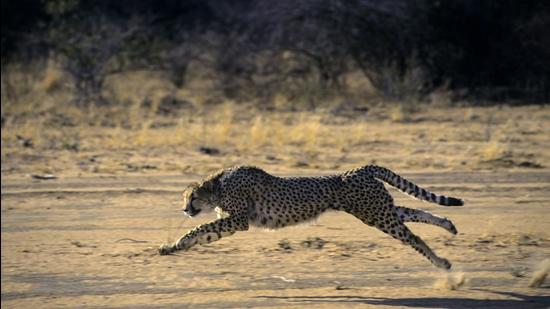African Cheetahs to be experimentally introduced in India in the next 4-6 months
In the first phase, 12 to 15 cheetahs are likely to arrive later this year or early in 2022 but over the next five years 40 to 50 are likely to be reintroduced
Cheetahs from Namibia and South Africa are likely to reach too India in the next four to six months, and be reintroduced in Kuno national park in Madhya Pradesh, Union environment ministry officials have confirmed. The move comes 74 years after the last of the big cats was killed in India. The cheetah was declared extinct in the country in 1952.

“We are expecting African Cheetahs to arrive in the next 4-6 months. The Kuno national park is being prepared for reintroduction,” said Gaurav Khare, official spokesperson of the environment ministry.
In the first phase, 12 to 15 cheetahs are likely to arrive later this year or early in 2022 but over the next five years 40 to 50 are likely to be reintroduced, SP Yadav, member secretary at the National Tiger Conservation Authority (NTCA), which is overseeing the project, said
“Experts from South Africa visited Kuno and found the habitat suitable for reintroduction. In fact, they said it is better than some of their habitats in South Africa. Reintroduction will take months. First, we need to see if they (the cheetahs) are able to kill prey in a very large enclosure,” explained Yadav.
Chital, chinkara and black bucks may be suitable prey for cheetahs in India, according to experts. Yadav said cheetahs don’t necessarily require grasslands, and that the forests of central India and parts of Rajasthan are best suited for them.
“Our understanding is that their habitat is varied. The last time cheetahs were seen in the wild was in the Sal forests of Chhattisgarh,” said Yadav adding that “each Cheetah requires around 10 to 20 sq km area. They are small cats so they need a far smaller area than say a tiger. There is no record of a Cheetah attacking humans. Their prey base is mostly small ungulates (hooved mammals).”
The International Union for Conservation of Nature (IUCN) lists the Asiatic Cheetah to be critically endangered. With a historic distribution across southwest and central Asia to India, the Asiatic Cheetah is now only known to occur with certainty in Iran. The population is very small, the IUCN states. Because of extremely low numbers of the Asiatic Cheetah, African Cheetahs, another subspecies are being considered for reintroduction in India but the experiment has been criticised by some scientists.
“Firstly, this is not reintroduction but introduction of African Cheetahs to India. They belong to the African continent. The Kuno Palpur sanctuary hasn’t been prepared for cheetahs which need large open areas and small catchable prey. The Chinkara group size in Kuno is very small and Chital group size is also shrinking due to loss of open grasslands. We have to be very cautious of zoonotic diseases also during this experiment. It would have been better if suitable habitat was developed before bringing them,” said Fayaz Khudsar, a wildlife biologist who conducted field research in Kuno in the late 90’s.
The SC on January 28, 2020 approved the introduction of the African Cheetah in India on an experimental basis in a carefully chosen habitat which will be closely monitored to assess if the cat can adapt to Indian conditions. NTCA approached SC regarding introduction of African Cheetahs to India.
The Wildlife Institute of India in collaboration with the Wildlife Trust of India assessed potential sites and as long back as 2010 recommended Kuno Palpur Wildlife Sanctuary in Madhya Pradesh; Shahgarh landscape in Jaisalmer (Rajasthan); and Nauradehi Wildlife Sanctuary in Madhya Pradesh for introduction of the African Cheetah.
In 2013, SC imposed a stay on introduction of African Cheetahs to Kuno because it was an ideal habitat for the Asiatic Lion.
The Asiatic cheetah was driven to extinction in India and the genetically very similar African cheetah which numbers about 12000 wild individuals, was favoured as seed stock for reintroduction. The International Union for the Conservation of Nature (IUCN) whose opinion was sought by the Government in this regard, approved this proposal according to a note by Wildlife Trust of India.
“There are several sites that are being surveyed for the Cheetah including Nauradehi Wildlife Sanctuary in Madhya Pradesh, Mukundara in Rajasthan, desert grasslands of Rajasthan or in Gujarat if you reclaim the grasslands. The Cheetah habitat in India historically is from Jammu to Tamil Nadu, very widespread and they were found in any habitat dry forests, grasslands, scrub forest etc. So, they will survive quite happily. In India they survived with lions, leopards and tigers. As long as there is enough food and there is protection they will regenerate on their own. Cheetahs in Namibia are being killed by farmers why not reintroduce them into their former habitat?” asked Divyabhanusinh Chavda, heads the Advisory Board at World Wide Fund For Nature, India. He is also a Cheetah expert.
Get Current Updates on India News, Lok Sabha Election 2024 live, Infosys Q4 Results Live, Elections 2024, Election 2024 Date along with Latest News and Top Headlines from India and around the world.



